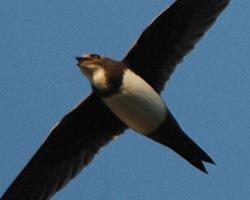
Poids et mesures
| Longueur | de 16 à 17 cm |
|---|---|
| Vitesse | de 35 à 200 km/h |
| Envergure des ailes | de 42 à 48 cm |
Statut de conservation
| Menacé |
Description de l'animal
The Common Swift (Apus apus) is a fascinating and enigmatic bird, renowned for its remarkable flying abilities and unique lifestyle. This medium-sized bird is part of the Apodidae family, which is characterized by their highly specialized body structure tailored for an aerial lifestyle. The Common Swift exhibits a sleek, streamlined body, predominantly cloaked in a deep, sooty brown plumage, with a slightly paler throat. They possess a wingspan that can reach up to 40-44 cm, allowing them superior maneuverability and speed in the air.One of the most striking features of the Common Swift is its long, scythe-like wings, which are perfectly adapted for a life spent almost entirely on the wing. These birds are capable of remarkable feats of endurance, spending months at a time flying without ever touching the ground. They eat, sleep, and even mate in the air, only landing to nest and rear their young.
The Common Swift's aerodynamic body is complemented by its short, forked tail and small, compact body, weighing around 40 grams. Their feet are small and adapted for clinging rather than walking, with all four toes facing forward. This adaptation is ideal for their nesting habits, as they typically nest in high, inaccessible places such as cliffs, tall buildings, and church steeples, where they can launch themselves into the air with minimal effort.
Common Swifts are highly social birds, often seen flying in screaming parties over towns and cities during the summer months. Their call is a distinctive, high-pitched series of screams, which adds to the atmospheric sounds of urban and rural settings alike during their breeding season.
Diet-wise, the Common Swift feeds almost exclusively on airborne insects and spiders, which they catch in their wide, gaping mouths while in flight. This diet supports their high-energy lifestyle and the demands of their long migratory journeys.
Speaking of migration, the Common Swift is a long-distance migrant, spending its breeding season in Europe and parts of Asia from late April to August, before embarking on an incredible journey to sub-Saharan Africa, where it spends the winter. The migration of the Common Swift is a testament to its extraordinary flying ability, with individuals covering thousands of kilometers in their biannual migrations.
The breeding habits of the Common Swift are as unique as their lifestyle. They are monogamous birds, often returning to the same nesting site year after year. The nest is a simple structure, built by both parents, who glue together materials like feathers and bits of debris with their saliva. Here, they lay 2 to 3 eggs, which are incubated for about 18-20 days. The fledglings remain in the nest for another 6 to 8 weeks before they are ready to take their first flight, embarking on their own aerial adventures.
The Common Swift plays a significant role in the ecosystem as a control for airborne insect populations. However, like many species, they face threats from habitat loss, climate change, and pollution. Conservation efforts are crucial to ensure that these remarkable birds continue to grace our skies with their presence.
In conclusion, the Common Swift is a bird of extraordinary abilities and intriguing habits. Its life spent almost entirely in the air, remarkable migratory journeys, and distinctive social behaviors make it a subject of great interest and admiration among bird enthusiasts and researchers alike.
Carte de répartition

Animaux similaires
Nouvelles photos d'animaux
Top 10 des animaux
- Dolphin gull (Leucophaeus scoresbii)
- Diana monkey (Cercopithecus diana)
- Moustached guenon (Cercopithecus cephus)
- Galápagos tortoise (Geochelone nigra complex)
- Russian tortoise (Testudo horsfieldii)
- Japanese macaque (Macaca fuscata)
- Stone loach (Barbatula barbatula)
- Greek tortoise (Testudo graeca)
- Common flying dragon (Draco volans)
- Colossal squid (Mesonychoteuthis hamiltoni)
